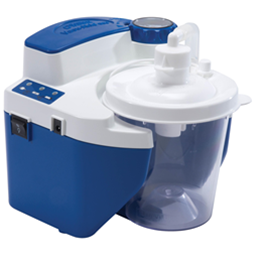Vacu-Aide® QSU Suction Unit
From DeVilbiss
For more than half a century, DeVilbiss Healthcare has provided unmatched safety and performance in the airway suction device category. With the Vacu-Aide QSU, DeVilbiss brings you the same reliable, portable operation in a significantly quieter unit View more
For more than half a century, DeVilbiss Healthcare has provided unmatched safety and performance in the airway suction device category. With the Vacu-Aide QSU, DeVilbiss brings you the same reliable, portable operation in a significantly quieter unit.
With more than 50% reduction in sound, the Vacu-Aide QSU is the quietest high flow/high suction portable unit on the market, making it a smart choice for patients from neonate to adult.
Product Highlights
- Vacuum adjustment allows for 50–550 mm Hg and a free flow of 27 liters/minute
- Meets American Association for Respiratory Care (AARC) guidelines for neonatal, infant, child and adult homecare suctioning
- Sealed lead acid battery for use up to one-hour operation
- Can return a patient to a state of comfort quickly – Meets ISO 10079-1:2009 high vacuum, high flow classification
- New, innovative container assembly features integrated bacteria filter
— Container and filter design maintains appropriate flow rate to meet ISO guidelines
- Comes complete with internal battery, carrying case, 6' tubing, AC/DC adapters and power cord
- New Integrated gauge and flow regulator – Easy-to-turn knob conveniently placed around gauge for easy use and control
- Manufactured and tested to ISO10079-1:1999 Standard for Suction Equipment, achieving outstanding performance in the following tests:
- Electromagnetic Compatibility Test – Vacu-Aide does not interfere with or is not susceptible to interference from other equipment such as ventilators
- Drop Test and Shock Vibration Test – Vacu-Aide is far less likely to be damaged when dropped or shipped
- Excessive Temperature Test – Vacu-Aide effectively works in a wide range of environmental temperatures - AARC Guidelines for appropriate subatmospheric pressures:
Neonates: 60 - 80 mm Hg
Infants: 80 - 100 mm Hg
Children: 100 - 120 mm Hg
Adults: 100 - 150 mm Hg
Negative pressures should not exceed 150 mmHg as higher pressures have been shown to cause trauma, hypoxemia and atelectasis.
Customer Reviews
There are no reviews written for this product at the time. Maybe you can be the first!

